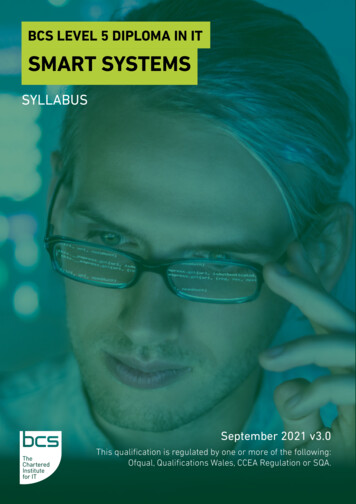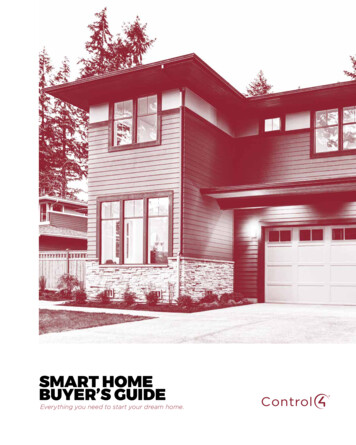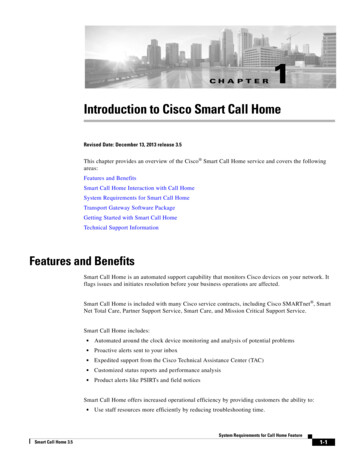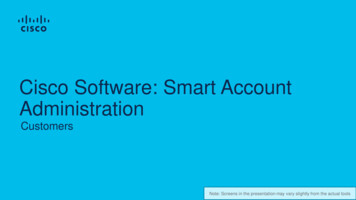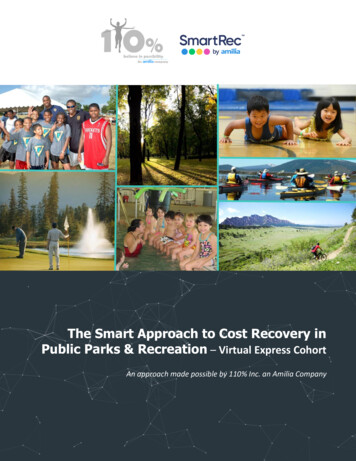
Transcription
The Smart Approach to Cost Recovery inPublic Parks & Recreation – Virtual Express CohortAn approach made possible by 110% Inc. an Amilia Company
A Call to Action for Public Parks & RecreationAmong the biggest challenge the public-sector faces are managing historic customer and communityexpectations that tax dollars foot the bill for most or all governmental services including parks andrecreation. The uncharted territory in which many professionals now find themselves includes thereality that subsidy dollars only be directed to services that provide for the greatest public good, and anexpectation of heightened cost recovery or excess revenue generation for services that provide moreindividualized benefit and not a broader impact on the community as a whole.The business of public parks and recreation (and arguably, government in general) is at a criticalcrossroad and has been profoundly impacted by a number of key issues including: increased interest ingovernmental accountability; increased competition from all sectors; stable or declining revenues withincreasing costs; rampant arbitrary pricing and antiquated financial accounting processes; rapidlychanging demographics; and maintenance backlogs and deteriorating infrastructure that seem farbeyond recovery.Operating from a foundation built upon sound business principles does indeed challenge conventionalwisdom in the public sector. It charges employees with being more diligent about their managementdecisions with the expectation that they justify how resources are used. It requires the establishment oforganization cultures that reflect an interest in defensible management practices and justifying how taxdollars are spent. It encourages productivity and the pursuit of opportunities for efficiency and revenuegrowth knowing that these efforts can help strengthen systems for the long term. And by applyingbusiness principles the long-held notion that certain services can continue to be subsidized because theyalways have been or because there is a demand that they are is challenged.We are in this together.Our commitment is to help set your organization up for long-term financialresilience, strength, and vitality with the Smart Approach to Cost Recovery.Page 2 of 6
The Smart Approach to Cost Recovery - Virtual Cohort process at a glanceToday’s economic and public health crises have prompted the urgency for many organizations to adoptthe Smart Approach to Cost Recovery. These new realities have presented a limited window of time tocomplete this critical work along with the added constraint of entirely virtual efforts. In order to meetthese challenges, The Smart Approach – Virtual Express Cohort process was created.The Virtual Express Cohort process involves multiple agencies within the same geographic region in thiscollegial yet individualized effort. Agencies are guided though a prescribed mix of collective cohorteducation sessions as well as specialized consulting designed in response to each individual organizationbased upon its conditions and realities.Cohorts: Small organization cohort: 4-6 agencies withoperational budgets under 10M Mid-sized organization cohort: 3-4 agencieswith operational budgets between 10 25M Large organization cohort: 2-3 agencieswith operational budgets over 25MProposed timeline: 12 weeksProposed price: 5975 per small organization; 7975per mid-sized organization; 9975 per largeorganizationIncluded: SmartRec Cost Recovery online Tool byAmiliaIncluded for 6 months after projectconcludes. Renewals are available.The Consulting TeamFarrell Buller is the Deputy Town Administrator for the Town of Erie, Colorado, and aproject consultant for 110%. A former parks and recreation director, she brings 20 yearsof practical experience and a lengthy list of accomplishments as a governmentemployee with a strong commitment to fiscal responsibility and accountability to eachcost recovery/financial management project.Eric Perowne is a Cost Recovery Associate at Amilia, a park and recreation software company.Eric specializes in helping organizations organize and sort their data efficiently by guidingthem in the use of Amilia cost recovery tool. Eric’s background in both technology andhospitality provides him with an impressive combination of skills that support cost recoverywork in parks and recreation.Jamie Sabbach is the founder and CEO of 110% Inc, helping organizations be moreresponsible, strategic, and bold amid dynamic social, environmental, and economicchange and a company that has become synonymous with financial responsibility inparks and recreation. Over the course of her 30 year career, she has served as park andrecreation practitioner, university faculty, and as a consultant. Jamie has testified to theUnited States Congress on the critical importance of parks and public lands and hasbeen recognized on numerous national stages for her work. She was inducted into the American Academy for Parkand Recreation Administration in 2008.Nicolas Venditti is the Cost Recovery Partnerships Manager at Amilia, a park and recreationsoftware company. Like Eric, Nick specializes in helping agencies organize and sort their dataefficiently by guiding them in the use of Amilia’s cost recovery tool. He has been involved inthe success of cost recovery projects with various sized agencies across the country.Page 3 of 6
The Smart Approach to Cost Recovery - Virtual Cohort Scope of WorkThe Smart Approach to Cost Recovery – Virtual Express Cohort process is a program designed in five (5)phases combining educational trainings, recorded webinars, interactive digital work sessions and one-onone meetings.Phase 1Kick-offMeetingStaffEducation &TrainingPhase 2Phase 3Phase 4Phase 5ServiceCategoryDevelopmentCost ofServiceAnalysisBeneficiary ofServiceWorkshop(s)UnveilCost ofServiceProject Kick-off Virtual Meeting with each Organization’s Project Team(scheduled approx. 2-3 weeks prior to Phase #1) Project team expectationsReview of each project phaseData and information requestReview of project timelineExpected quality and format of all deliverablesPreparation of and planning for Phase 1Phase 1Staff Education & Training:1 1/2 -hour Live VirtualWorkshopEducation and training on thefront end of the process withup to 20 staff per organizationprovides a comprehensiveunderstanding of the process,why the organization wouldchoose to engage, and how theoutcomes are ultimatelyintended to positively affectoperations. Further, it offers anintroduction to the topics of financial management and cost recovery in the public sector and enhancededucation on the merits of how revenues are and/or may be generated, how to think about spending,and about the importance of a cost recovery philosophy for sustaining parks and recreation systemslong term.Page 4 of 6
Phase 2Service Category Development: 1-hour Live Virtual Work SessionA team of representative organization staff will be tasked with the development of the organization’sinitial working draft of service categories. Resources will be provided to the organization to assist in theself-directed development of service categories as well as category definitions.Phase 3Cost of Service AnalysisThe Cost of Service Analysis is the “heavy lifting” phase of the process. Staff who are needed to assistwith this phase of the process include but are not limited to those at an administrator level along withthose who are “gatekeepers” of the organization’s financial data.A Data Import Spreadsheet (DIS) and supplemental instructional guide along with support from theconsulting team will be provided to assist the organization and ensure there is clarity and understandingregarding data identification and collection. This cost of service analysis will be supported by: A Cost of Service Workshop & Introduction to Cost Recovery Tool – 1-hour live online session Ten one-hour work online sessions with specific project team members to facilitate the work. Weekly check-ins with the organization’s project team (as needed).The weekly check-in meetings will be held until such time that all necessary costs and revenues havebeen incorporated into the DIS, and there is a high level of confidence in the integrity and accuracy ofthe data and that all reasonable assumptions have been made and documented.Phase 4Beneficiary of Service WorkshopsOnce the organization’s service categories have been developed and agreed upon, staff, policy makersand/or advisory boards and stakeholder groups will actively participate in determining each servicecategory’s “beneficiary of service”.Organization staff, council and/or boards can be invited to participate in workshops where participantsrank the organization’s service categories starting from services generating the greatest “communitybenefit” to those services generating the greatest “individual benefit”.The result of these workshops allows for the organization to begin building their cost recovery model - avisual representation of their strategy. By plotting all service categories on a continuum that illustrateswhich services provide for the common good in contrast to those services which are more individualizedand specialized, the organization begins to see which services should receive the greatest subsidy(community benefit) in contrast to those that may receive little to no subsidy (individual benefit).Page 5 of 6
Phase 5Unveil the Results of Cost of Service Analysis & Set Cost Recovery GoalsAfter the data collection and importing processes conclude, staff will view the organization’s CostRecovery Tool and the results of the cost of service analysis. These data and supplemental reportsinclude the cost to provide (both direct and indirect) each individual service in the system, current costrecovery performance levels and a series of other important information.Current cost recovery performance results can be used as the baseline from which the organization canjustifiably and rationally set cost recovery/subsidy allocation goals and targets that will be placed ontheir cost recovery model, essentially completing this visual representation of the organization’sphilosophy. Results will also guide the organization in establishing fees and charges, and making otherinformed financial decisions moving forward.Key DeliverableCost Recovery Model & StrategyOnce the cost of service analysis is complete and the organization determines cost recovery/subsidyallocation goals that are credible and relevant based upon current performance, analysis insights andbudget projections, theorganization’s costrecovery model andstrategy takes shape.This key actionabledeliverable sets the stagefor implementation andmomentum towardsaligning today’s fiscalreality with theorganization’s tax useand revenueenhancement philosophyas designed throughoutthe process.This unique approach is designed and offered to North American park & recreationorganizations by:Page 6 of 6
The Smart Approach to Cost Recovery in Public Parks & Recreation - Virtual Express Cohort An approach made possible by 110% Inc. an Amilia Company . Unveil the Results of Cost of Service Analysis & Set Cost Recovery Goals After the data collection and importing processes conclude, staff will view the organization's Cost



